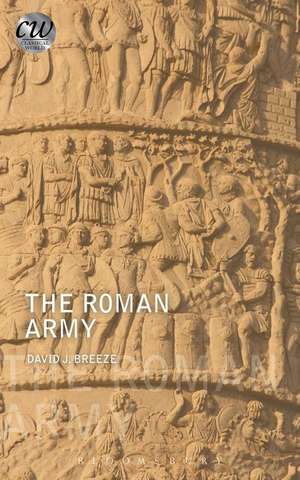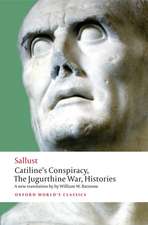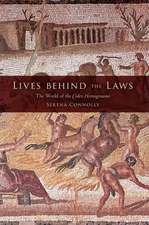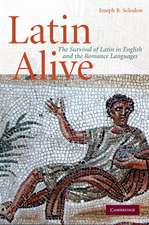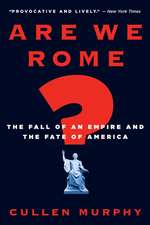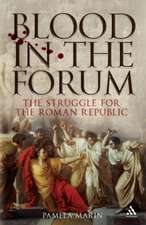The Roman Army: Classical World
Autor David J. Breezeen Limba Engleză Paperback – 10 feb 2016
Din seria Classical World
-
 Preț: 138.93 lei
Preț: 138.93 lei - 14%
 Preț: 112.27 lei
Preț: 112.27 lei - 13%
 Preț: 107.75 lei
Preț: 107.75 lei - 19%
 Preț: 125.46 lei
Preț: 125.46 lei - 15%
 Preț: 143.62 lei
Preț: 143.62 lei - 19%
 Preț: 130.75 lei
Preț: 130.75 lei - 15%
 Preț: 148.72 lei
Preț: 148.72 lei - 15%
 Preț: 149.16 lei
Preț: 149.16 lei - 14%
 Preț: 149.61 lei
Preț: 149.61 lei - 14%
 Preț: 150.05 lei
Preț: 150.05 lei - 14%
 Preț: 117.75 lei
Preț: 117.75 lei - 17%
 Preț: 122.63 lei
Preț: 122.63 lei - 19%
 Preț: 117.75 lei
Preț: 117.75 lei - 19%
 Preț: 130.22 lei
Preț: 130.22 lei - 19%
 Preț: 130.49 lei
Preț: 130.49 lei - 15%
 Preț: 149.52 lei
Preț: 149.52 lei - 15%
 Preț: 149.35 lei
Preț: 149.35 lei - 15%
 Preț: 129.59 lei
Preț: 129.59 lei - 14%
 Preț: 130.22 lei
Preț: 130.22 lei - 14%
 Preț: 150.05 lei
Preț: 150.05 lei - 15%
 Preț: 129.77 lei
Preț: 129.77 lei - 20%
 Preț: 148.98 lei
Preț: 148.98 lei - 14%
 Preț: 130.75 lei
Preț: 130.75 lei - 19%
 Preț: 130.22 lei
Preț: 130.22 lei - 19%
 Preț: 131.47 lei
Preț: 131.47 lei - 19%
 Preț: 130.22 lei
Preț: 130.22 lei - 19%
 Preț: 130.15 lei
Preț: 130.15 lei - 14%
 Preț: 130.15 lei
Preț: 130.15 lei - 14%
 Preț: 130.32 lei
Preț: 130.32 lei - 14%
 Preț: 149.87 lei
Preț: 149.87 lei - 14%
 Preț: 130.32 lei
Preț: 130.32 lei - 19%
 Preț: 130.22 lei
Preț: 130.22 lei - 19%
 Preț: 130.40 lei
Preț: 130.40 lei - 19%
 Preț: 131.29 lei
Preț: 131.29 lei - 14%
 Preț: 130.32 lei
Preț: 130.32 lei - 15%
 Preț: 149.27 lei
Preț: 149.27 lei - 19%
 Preț: 131.29 lei
Preț: 131.29 lei - 14%
 Preț: 130.22 lei
Preț: 130.22 lei - 15%
 Preț: 130.03 lei
Preț: 130.03 lei - 14%
 Preț: 150.33 lei
Preț: 150.33 lei - 15%
 Preț: 148.82 lei
Preț: 148.82 lei -
 Preț: 148.82 lei
Preț: 148.82 lei - 14%
 Preț: 149.61 lei
Preț: 149.61 lei - 14%
 Preț: 150.05 lei
Preț: 150.05 lei - 19%
 Preț: 105.01 lei
Preț: 105.01 lei - 19%
 Preț: 123.95 lei
Preț: 123.95 lei -
 Preț: 143.78 lei
Preț: 143.78 lei
Preț: 151.38 lei
Preț vechi: 186.73 lei
-19% Nou
Puncte Express: 227
Preț estimativ în valută:
28.97€ • 30.24$ • 23.97£
28.97€ • 30.24$ • 23.97£
Carte tipărită la comandă
Livrare economică 05-19 aprilie
Preluare comenzi: 021 569.72.76
Specificații
ISBN-13: 9781474227155
ISBN-10: 1474227155
Pagini: 168
Ilustrații: 25 bw illus
Dimensiuni: 138 x 216 x 13 mm
Greutate: 0.25 kg
Editura: Bloomsbury Publishing
Colecția Bloomsbury Academic
Seria Classical World
Locul publicării:London, United Kingdom
ISBN-10: 1474227155
Pagini: 168
Ilustrații: 25 bw illus
Dimensiuni: 138 x 216 x 13 mm
Greutate: 0.25 kg
Editura: Bloomsbury Publishing
Colecția Bloomsbury Academic
Seria Classical World
Locul publicării:London, United Kingdom
Caracteristici
Understanding the Roman army helps us to understand the frontiers and forts which it constructed, including Hadrian's Wall
Notă biografică
David J. Breeze is an honorary professor at the Universities of Durham, Edinburgh and Newcastle. Chairman of the International Congress of Roman Frontier Studies and former Chief Inspector of Ancient Monuments, Scotland, he has written on the Roman army and on Roman frontiers, including Hadrian's Wall (4th edn, 2000), Roman Frontiers in Britain (Bloomsbury, 2013) and The Frontiers of Imperial Rome (2011).
Cuprins
List of Illustrations PrefaceAcknowledgements Money, Measurements and Dates Introduction 1. The Republican Army2. The Army of Augustus and His Successors3. The Army on Campaign4. The Fighting Tactics of the Roman army5. The Army in Peacetime6. Arms and Armour7. Soldiers as Builders8. The Late Roman ArmyConclusions GlossarySelect List of Roman EmperorsSuggestions for Further StudyFurther Reading
Recenzii
This is an excellent book, immensely valuable to students and general readers, and well worth careful scrutiny by scholars.
This little book is a gem. It draws together from all available sources a concise picture of the Roman army through the ages. As always, [Breeze] writes with pellucid clarity. His book is a pleasure to read ... [and] is to be warmly recommended to everyone with an interest in Roman history or military history generally.
Easy to read, informative, and occasionally funny ... [Breeze] manages to cover a wide range of topics in a compact book, while discussing some at times complex and technical issues in an accessible way.
A distinguished addition to a series from Bloomsbury Publishing already noted for the quality and range of its titles ... One of the book's principal achievements lies in the deftness with which information is provided, discussed and theories developed - all of it supported by a range of evidence ... Breeze is to be congratulated on the production of an informative, clear and eminently readable treatment of a complex subject.
Breeze (Univ. of Edinburgh, Scotland) offers an accessible introduction to his subject. The book is organized both chronologically and thematically, but it neither is nor purports to be a history of the army or of Roman warfare, for which see Jonathan Roth's comparably priced Roman Warfare (CH, Oct'10, 48-1032). Breeze covers such topics as equipment, engineering, and the function of the army beyond the battlefield. Within this structure, the author refers to major battles and campaigns to illustrate specific tactical maneuvers and strategic decisions. The brief chapters discuss material culture, including archaeological discoveries, monuments, and inscriptions, from throughout the Roman Empire, as well as documentary sources. . this book provides a clearly written and well-illustrated introduction to a topic of enduring fascination. Summing Up: Recommended. General, public, and undergraduate collections.
[A] glossary, thematic index and bibliography usefully complement a well-written work, offering a nuanced view of the Roman army. (Bloomsbury Translation)
The work is rounded off by a succinct introduction which details the main kinds of sources (textual, epigraphic, sculptural, iconographic and archaeological), not forgetting the value of experimental archaeology with its reconstructions of armaments and formations. In addition to an appreciable amount of illustrations, maps, tables, a thematic index and a glossary, we're grateful for the inclusion of a list of materials to deepen the study of this subject and a bibliography segmented in themes (old sources, navy, equipment, etc.) to make a specific search easier. (Bloomsbury translation)
David Breeze distils a lifetime of studying the Roman army into an authoritative, short volume, packed with accurate and detailed information about all aspects of one of the most successful organisations of the ancient world. This little book provides an excellent survey of the subject for students and scholars alike.
I can think of no one better qualified than David Breeze to write an overview of the Roman army. He has succeeded in providing a succinct account of one of the most famous armies in history which is both comprehensive and authoritative, yet very readable.
This little book is a gem. It draws together from all available sources a concise picture of the Roman army through the ages. As always, [Breeze] writes with pellucid clarity. His book is a pleasure to read ... [and] is to be warmly recommended to everyone with an interest in Roman history or military history generally.
Easy to read, informative, and occasionally funny ... [Breeze] manages to cover a wide range of topics in a compact book, while discussing some at times complex and technical issues in an accessible way.
A distinguished addition to a series from Bloomsbury Publishing already noted for the quality and range of its titles ... One of the book's principal achievements lies in the deftness with which information is provided, discussed and theories developed - all of it supported by a range of evidence ... Breeze is to be congratulated on the production of an informative, clear and eminently readable treatment of a complex subject.
Breeze (Univ. of Edinburgh, Scotland) offers an accessible introduction to his subject. The book is organized both chronologically and thematically, but it neither is nor purports to be a history of the army or of Roman warfare, for which see Jonathan Roth's comparably priced Roman Warfare (CH, Oct'10, 48-1032). Breeze covers such topics as equipment, engineering, and the function of the army beyond the battlefield. Within this structure, the author refers to major battles and campaigns to illustrate specific tactical maneuvers and strategic decisions. The brief chapters discuss material culture, including archaeological discoveries, monuments, and inscriptions, from throughout the Roman Empire, as well as documentary sources. . this book provides a clearly written and well-illustrated introduction to a topic of enduring fascination. Summing Up: Recommended. General, public, and undergraduate collections.
[A] glossary, thematic index and bibliography usefully complement a well-written work, offering a nuanced view of the Roman army. (Bloomsbury Translation)
The work is rounded off by a succinct introduction which details the main kinds of sources (textual, epigraphic, sculptural, iconographic and archaeological), not forgetting the value of experimental archaeology with its reconstructions of armaments and formations. In addition to an appreciable amount of illustrations, maps, tables, a thematic index and a glossary, we're grateful for the inclusion of a list of materials to deepen the study of this subject and a bibliography segmented in themes (old sources, navy, equipment, etc.) to make a specific search easier. (Bloomsbury translation)
David Breeze distils a lifetime of studying the Roman army into an authoritative, short volume, packed with accurate and detailed information about all aspects of one of the most successful organisations of the ancient world. This little book provides an excellent survey of the subject for students and scholars alike.
I can think of no one better qualified than David Breeze to write an overview of the Roman army. He has succeeded in providing a succinct account of one of the most famous armies in history which is both comprehensive and authoritative, yet very readable.
